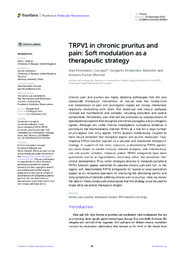Título :
TRPV1 in chronic pruritus and pain: Soft modulation as a therapeutic strategy |
Autor :
Fernandez-Carvajal, Asia 
Fernandez-Ballester, Gregorio 
Ferrer-Montiel, Antonio  |
Editor :
Frontiers Media |
Departamento:
Departamentos de la UMH::Bioquímica y Biología Molecular |
Fecha de publicación:
2022 |
URI :
https://hdl.handle.net/11000/34366 |
Resumen :
Chronic pain and pruritus are highly disabling pathologies that still lack
appropriate therapeutic intervention. At cellular level the transduction
and transmission of pain and pruritogenic signals are closely intertwined,
negatively modulating each other. The molecular and cellular pathways
involved are multifactorial and complex, including peripheral and central
components. Peripherally, pain and itch are produced by subpopulations of
specialized nociceptors that recognize and transduce algesic and pruritogenic
signals. Although still under intense investigation, cumulative evidence is
pointing to the thermosensory channel TRPV1 as a hub for a large number
of pro-algesic and itchy agents. TRPV1 appears metabolically coupled to
most neural receptors that recognize algesic and pruritic molecules. Thus,
targeting TRPV1 function appears as a valuable and reasonable therapeutic
strategy. In support of this tenet, capsaicin, a desensitizing TRPV1 agonist,
has been shown to exhibit clinically relevant analgesic, anti-inflammatory,
and anti-pruritic activities. However, potent TRPV1 antagonists have been
questioned due to an hyperthermic secondary effect that prevented their
clinical development. Thus, softer strategies directed to modulate peripheral
TRPV1 function appear warranted to alleviate chronic pain and itch. In this
regard, soft, deactivatable TRPV1 antagonists for topical or local application
appear as an innovative approach for improving the distressing painful and
itchy symptoms of patients suffering chronic pain or pruritus. Here, we review
the data on these compounds and propose that this strategy could be used to
target other peripheral therapeutic targets.
|
Palabras clave/Materias:
chronic pain
pruritus
therapeutic targets
TRP channels
soft drugs |
Área de conocimiento :
CDU: Ciencias puras y naturales: Biología: Bioquímica. Biología molecular. Biofísica |
Tipo de documento :
info:eu-repo/semantics/article |
Derechos de acceso:
info:eu-repo/semantics/openAccess
Attribution-NonCommercial-NoDerivatives 4.0 Internacional |
DOI :
https://doi.org/10.3389/fnmol.2022.930964 |
Publicado en:
Frontiers in Molecular Neuroscience |
Aparece en las colecciones:
Artículos - Bioquímica y Biología Molecular
|
 La licencia se describe como: Atribución-NonComercial-NoDerivada 4.0 Internacional.
La licencia se describe como: Atribución-NonComercial-NoDerivada 4.0 Internacional.
.png)
